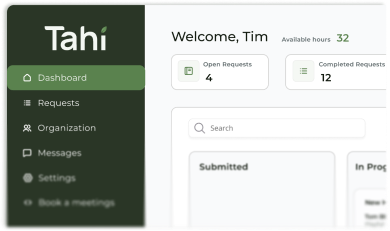Wireframe
A wireframe is a simple visual guide, like a blueprint for a website, that shows the basic structure and layout of pages before any design is added.
What is the main purpose of a wireframe in a web design project?
The main purpose of a wireframe is to act as a blueprint for a website or application. Think of it as the architectural skeleton of a digital page. It focuses purely on structure, layout, and the placement of key elements without the distraction of colours, fonts, or images. It maps out where things like navigation menus, buttons, text blocks, and images will go, and establishes the hierarchy of information on the page.
This early stage is all about function over form. By stripping away all the visual design, we can have clear conversations about the user's journey and the core purpose of each page. It's a foundational communication tool that allows designers and clients to agree on the fundamental layout and functionality before any time is invested in detailed visual design or development.
How are wireframes different from mockups and prototypes in Figma?
While they are all part of the design process, especially within a tool like Figma, they serve very different purposes. A wireframe is a low-fidelity, basic blueprint that shows the structure. It's the skeleton of the design, often created in greyscale with simple boxes and placeholder text.
A mockup is the next step up. It's a static, high-fidelity visual representation of the final product. Mockups add the skin to the skeleton by introducing colour palettes, typography, real imagery, and branding elements from your brand identity. It shows what the website will look like, but it isn't interactive. A prototype takes the high-fidelity mockup and makes it clickable. It simulates the user experience by adding links, transitions, and animations, allowing you to navigate through the design as if it were a live website. This journey from wireframe to mockup to prototype ensures every layer is perfected before development begins.
Why do we use wireframes before starting Webflow development?
Using wireframes before jumping into Webflow development is a crucial step that saves time, money, and future headaches. Making structural changes in a simple wireframe is incredibly fast and easy. Moving a button or rearranging a whole section takes minutes. Making that same change in a fully developed Webflow site, which has styles, interactions, and responsive settings applied, is far more complex and time consuming.
By finalising the structure in the wireframing stage, we ensure the strategic foundation is solid. This allows our Webflow developers to build with confidence, knowing the layout is client approved and logically sound. It helps define the Content Management System (CMS) needs early on and prevents significant structural rework down the line, leading to a much more efficient and streamlined development process that avoids costly technical debt.
What should a client look for when reviewing a wireframe?
When you review a wireframe, it's important to ignore your instincts to comment on visual aesthetics. Instead, focus entirely on structure and usability. Ask yourself questions like 'Is the most important information given the most prominence?' and 'Does the flow from one section to the next feel logical and intuitive for a user?'.
Check if all the necessary content and features have a designated place on the page. Does the user journey make sense? Can you easily find the main call to action? This is also the perfect time to consider your Ideal Client Profile and ensure the structure serves their needs. Providing feedback on this structural level is incredibly valuable through our collaborative process. This is the time to question the layout and hierarchy, not the specific wording or the shade of a button which will come later in the mockup stage.
How can a clear wireframing process lead to a better partnership with Tahi Studio?
At Tahi Studio, we believe a clear process builds trust and leads to exceptional results. Our wireframing stage is a key part of our commitment to transparency and collaboration. It ensures that we are perfectly aligned with you on the website's structure and user flow from the very beginning, preventing misunderstandings and costly revisions later on.
This structured approach is a cornerstone of our productised service. It allows us to move seamlessly from this approved blueprint into high-quality Figma designs and then into expert Webflow development through our proven handoff process, knowing the foundation is exactly what your business needs. This entire journey is managed transparently through your dedicated client dashboard, creating a true partnership focused on building a scalable digital presence that achieves your goals.






